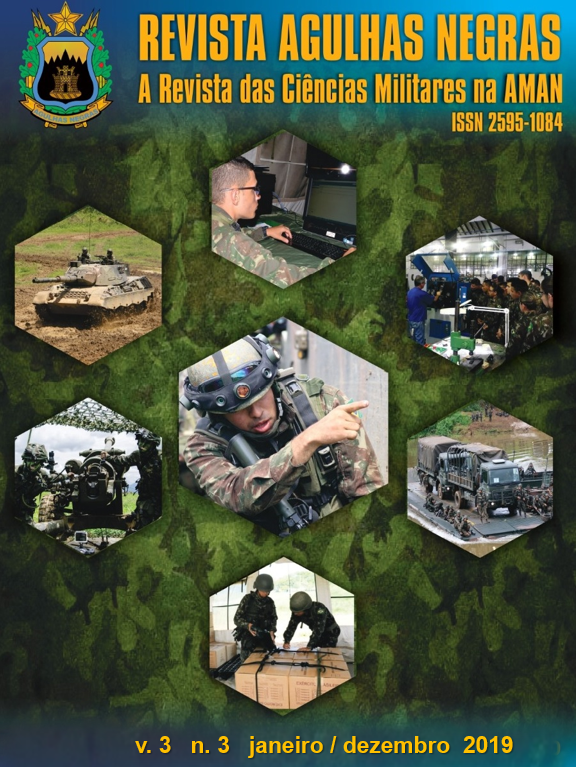A ESTRATÉGIA MODULAR NA PRODUÇÃO DE VEÍCULOS MILITARES SOB A ÓTICA DO SETOR AUTOMOBILÍSTICO
Resumo
O Artigo tem como tema a aplicação da estratégia modular na produção de blindados no Brasil sob a
ótica do setor automobilístico civil. Destina-se primeiramente a apresentar a estratégia modular,
adotada pela indústria automobilística, para em seguida analisar a aplicação da estratégia modular,
principalmente nas viaturas militares Astros e Guarani, produzidos hoje no Brasil pelas empresas
AVIBRAS e IVECO. Para atingir o objetivo foi realizada uma pesquisa descritiva, hipotéticodedutiva, na qual se buscou confirmar se a estratégia modular traz benefícios para a indústria
automobilística civil, ela também trará os mesmos benefícios para a indústria de veículos militares
brasileira. Conclui-se que a estratégia está sendo bem aplicada e trazendo benefícios semelhantes ao
que trouxe para a indústria civil, com algumas ressalvas.
Downloads
Referências
ALMEIDA, F. de A. G1 andou no Volkswagen Golf GT. G1 Globo, 2008. Disponível em:
http://g1.globo.com/Noticias/Carros/0,,MUL927980-9658,00 G+ANDOU+NO+VOLKSWAGEN+GOLF+GT.html.
Acesso em: 20 maio 2019.
ARNHEITER, E. D.; HARREN, H. A typology to unleash the potential of modularity. Journal of Manufacturing
Technology Management, v. 16, n. 7, p. 699-711, 2005. DOI: https://doi.org/10.1108/17410380510619923
BASTOS, E. C. S. Astros II o eficiente sistema de artilharia de foguetes brasileiro. Universidade Federal de Juiz de
Fora, 20??.
BAUMANN, R. O Brasil na economia global. Rio de Janeiro: Campus, 1996.
BALDWIN, C.Y.; CLARK K. B. Design Rules. Massachusetts: MIT Press, 2000. DOI: https://doi.org/10.7551/mitpress/2366.001.0001
CAMUFFO, A. Rolling out a World Car: Globalization, Outsourcing and Modularity in the Auto Industry.
IMVP, 2000.
CARNEVALLI, J. A. et al. Aplicação da modularidade na indústria automobilística: análise a partir de um
levantamento tipo survey. Produção, v. 23, n. 2, p. 329-344, abr./jun. 2013 DOI: https://doi.org/10.1590/S0103-65132012005000040
CARNEVALLI, J. A. et al. Modularidade em montadoras de automóveis: uma análise sob a ótica da estratégia.
Revista Produção Online, Florianópolis, SC, v.15, n. 2, p.433-457, abr./jun. 2015. DOI: https://doi.org/10.14488/1676-1901.v15i2.1741
DASCH, M. J.; GORSICH, J. D. Survey of Modular Military Vehicles. PhD—[s.l.], Maryland, 2016.
ESTADO MAIOR DO EXÉRCITO. Portfólio estratégico do Exército. Revista EPEX. 2018.
FLEURY, A. The changing pattern of operations management in developing countries. International Journal of
Operations & Production Management, v. 19, n. 5/6, 1993.
FRIEDMAN, T. L. O mundo é plano: uma breve história do século XXI. 2. Ed. Brasil, Objetiva, 2005.
HOFFMAN, O. Leopard 2expertise from Rheinmetall. Rheinmetall Defense press release, 2017.
LEVIN, J. Estatística aplicada a ciências humanas. 2. ed. São
Paulo: Harbra, 1987.
MELLO, A. M. D.; MARX, R. Innovative capacity maintenance by automakers in a product development
outsourcing scenario: the case of VW in Brazil. International Journal of Automotive Technology and Management, v.
, n. 2-3, p. 200-215, 2007.
MORRIS, D.; DONNELLY, T. Are there market limits to modularisation? International Journal of Automotive
Technology and Management, v. 6, n. 3 , p. 262-275, 2006.
ORSATO, R. J.; WELLS, P. U-turn: the rise and demise of the automobile industry. Journal of Cleaner Production,
v. 15, n. 11-12, p. 994-1006, 2007.
PANDREMENOS, J. et al. Modularity concepts for the automotive industry: A critical review. CIRP Journal of
Manufacturing Science and Technology, v. 1, n. 3, p. 148-152, 2009. DOI: https://doi.org/10.1016/j.cirpj.2008.09.012
PERSSON, M. Effects of changing a module’s interface: a case study in a automotive company. International
Journal of Automotive Technology and Management, v. 6, n. 3, p. 331-345, 2006. DOI: https://doi.org/10.1504/IJATM.2006.012124
PIRES, S. R. I. Managerial implications of the modular consortium model in a Brazilian automotive plant.
International Journal of Operations & Production Management, v. 18, n. 3, p.221-232, 1998. DOI: https://doi.org/10.1108/01443579810368290
SALERNO, M. S. The characteristics and the role of modularity in the automotive business. International Journal
of Automotive Technology and Management, v. 1, n. 1, p. 92-107, 2001. DOI: https://doi.org/10.1504/IJATM.2001.000029
SALERNO, M. S. et al. Mudanças e persistências no padrão de relações entre montadoras e autopeças no Brasil.
Revista de Administração, v. 33, n. 3, p. 16-28, 1998.
SALERNO, M. S. et al. Modularity ten years after: an evaluation of the Brazilian experience. International Journal
of Automotive Technology and Management, v. 8, n. 4, p. 373-381, 2008.
SAKO, M.; MURRAY, F. Modules in Design, Production and Use: implications for the global automotive
industry. Cambridge: IMVP. 1999.
SCAVARDA, L. F. R.; HAMACHER S. Evolução da Cadeia de Suprimentos da Indústria Automobilística no
Brasil, RAC, v. 5, n. 2, maio/ago, 2001.
SERIO, L. Di C. et al. A evolução dos conceitos de logística: um estudo na cadeia automobilística no Brasil.
Revista Administração e Inovação. São Paulo, v. 4, n. 1, p. 125-141, 2007.
SLACK, N. Vantagem competitiva em manufatura. São Paulo: Atlas, 1993.
WOOD, T.; ZUFFO, P. K. Supply chain management. Revista de Administração de Empresas, v. 38, n. 3, p. 55-63, DOI: https://doi.org/10.1590/S0034-75901998000300007









